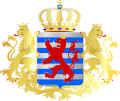Sources
- Gades, John A. (1951). Luxemburg in the Middle Ages. Brill.
- Morganstern, Anne McGee (2000). Gothic Tombs of Kinship in France, the Low Countries, and England. Penn State University Press.
| ||||||||||||||||||||
| ||||||||||||||||||||
| ||||||||||||||||||||
| | This biographical article about a member of the Luxembourgish nobility is a stub. You can help Wikipedia by expanding it. |


